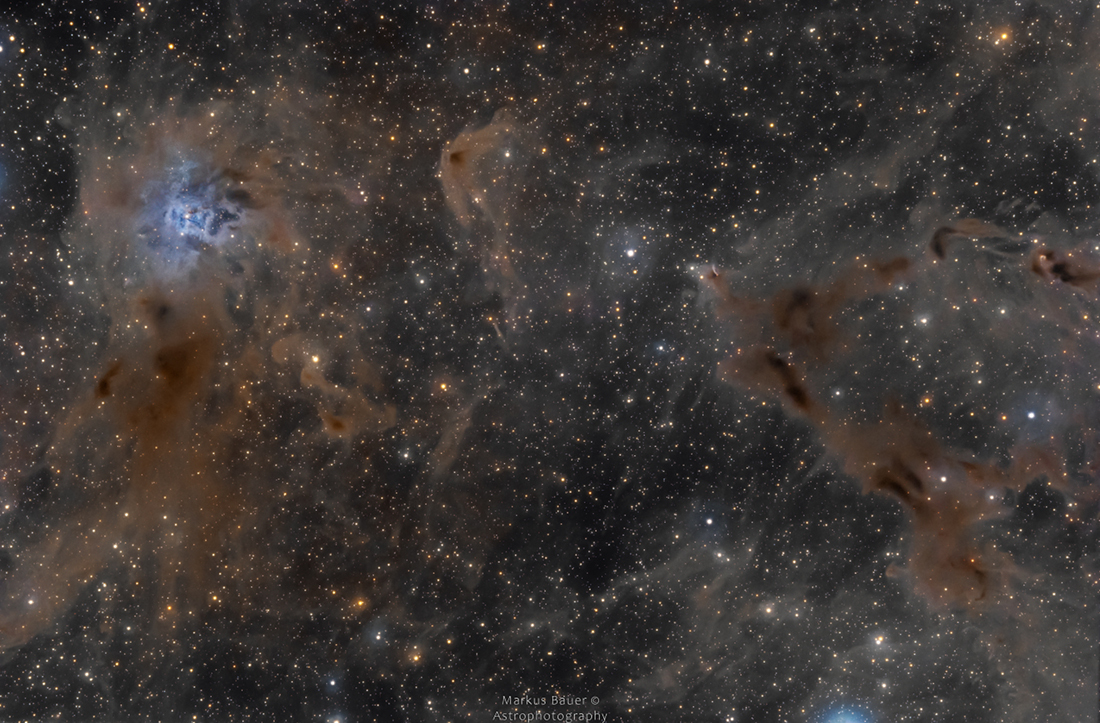
Add To Favorites
These cosmic dust clouds drift some 1,300 light-years away along the fertile starfields of the constellation Cepheus. The beautiful Iris Nebula, also known as NGC 7023, blossoms at the upper left. Not the only nebula in the sky to evoke the imagery of flowers, its pretty, symmetric form spans about 6 light-years. This nebula's dominant blue color is characteristic of the pervasive dust grains reflecting light from a nearby hot, bluish star. But darker, obscuring dust clouds cover most of the nearly 4 degree wide field of view. At the right is the LDN 1147/1158 complex of Lynds Dark Nebulae. Stars are forming there, still hidden within the dark cloud cores. A search through the sharp image can identify Herbig-Haro objects though, jets of shocked glowing gas emanating from recently formed stars.
2019-09-12 Markus Bauer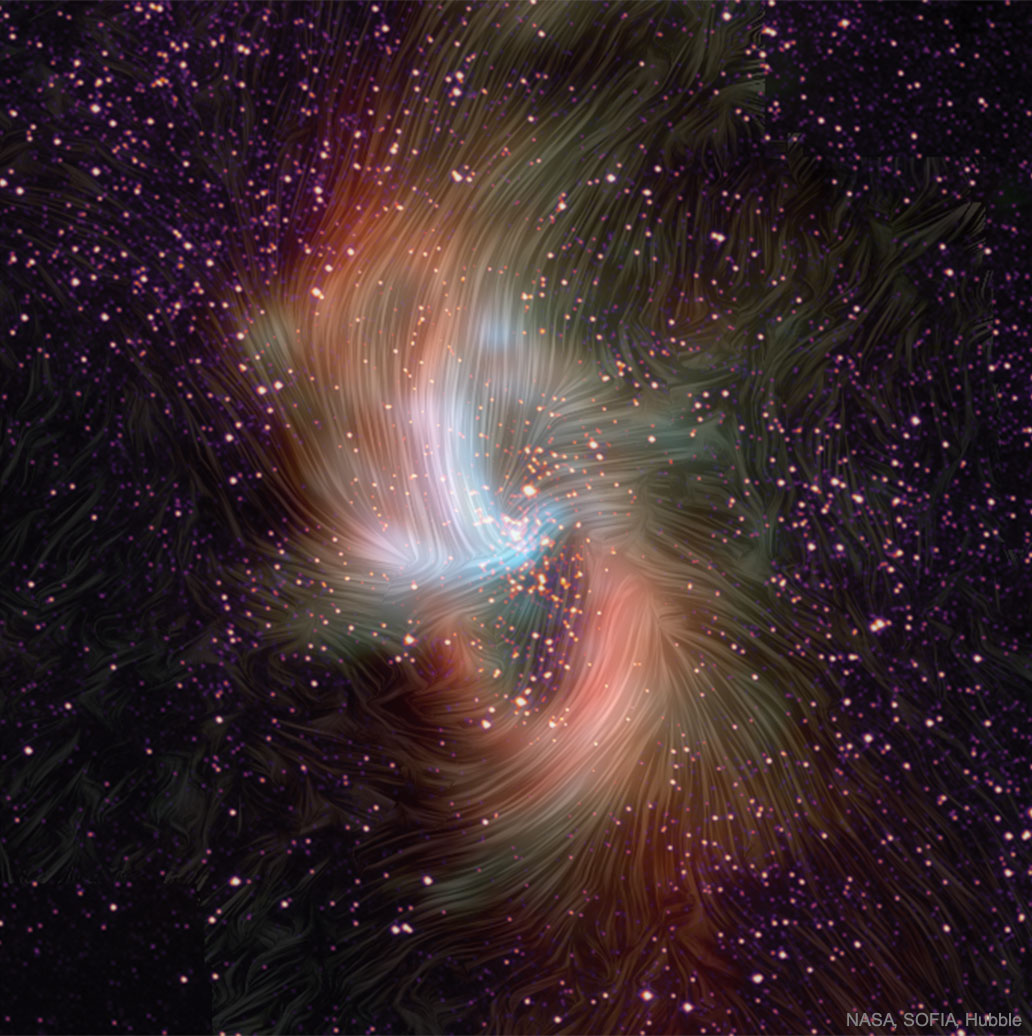
Add To Favorites
What's the magnetic field like in the center of our Milky Way Galaxy? To help find out, NASA's SOFIA -- an observatory flying in a modified 747 -- imaged the central region with an instrument known as HAWC+. HAWC+ maps magnetism by observing polarized infrared light emitted by elongated dust grains rotating in alignment with the local magnetic field. Now at our Milky Way's center is a supermassive black hole with a hobby of absorbing gas from stars it has recently destroyed. Our galaxy's black hole, though, is relatively quiet compared to the absorption rate of the central black holes in active galaxies. The featured image gives a clue as to why -- a surrounding magnetic field may either channel gas into the black hole -- which lights up its exterior, or forces gas into an accretion-disk holding pattern, causing it to be less active -- at least temporarily. Inspection of the featured image -- appearing perhaps like a surreal mashup of impasto art and gravitational astrophysics -- brings out this telling clue by detailing the magnetic field in and around a dusty ring surrounding Sagittarius A*, the black hole in our Milky Way's center.
2019-06-19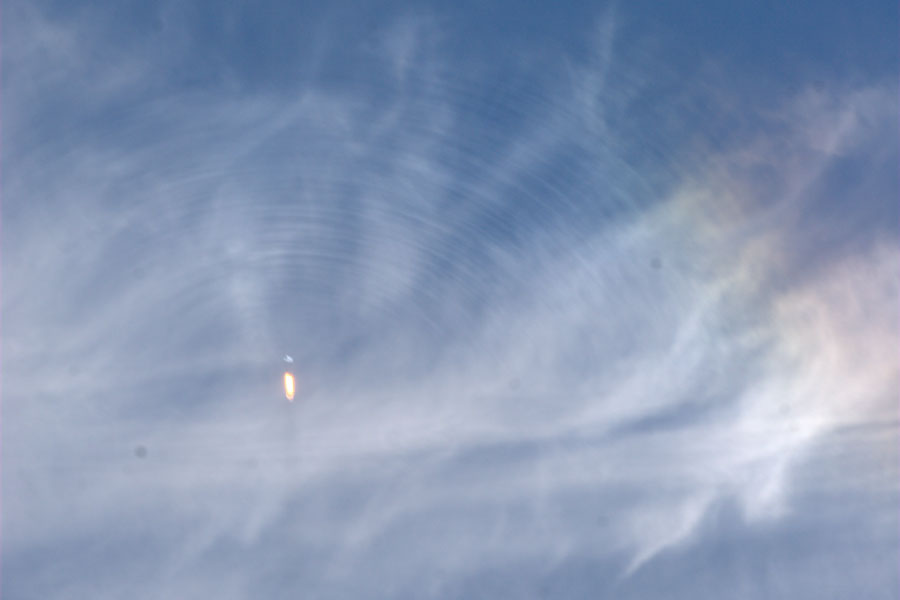
Add To Favorites
What created those rocket waves, and why did they destroy that sun dog? Close inspection of the above image shows not only a rocket rising near the center, but unusual air ripples around it and a colorful sundog to the far right. The rocket, carrying the Solar Dynamics Observatory (SDO), lifted off two weeks ago from Cape Canaveral, Florida, USA into a cold blue sky. The SDO is designed to observe the Sun continuously over the next several years, exploring the Sun's atmosphere at high resolution and fast time scales. The air ripples -- seen about one minute after launch -- were unexpected, as was the sudden disappearance of the sundog after the ripples passed. Noticed and recorded by several onlookers, there has been much speculation about the origin of the ripples. An ongoing discussion about them can be joined here in APOD's discussion board the Asterisk. A leading hypothesis holds that the ripples resulted from a sonic boom created as the rocket broke the sound barrier, which then jumbled a thin layer of ice crystals that were aligned to create the sundog. Lingering questions include why other rocket launches don't produce air ripples as noticeable, and why the ripples appeared more prominent above the rocket. If you know of images of any other aircraft or spacecraft that have produced similar air ripples, please post them to the discussion thread -- they may be help create a better understanding of the effect.
2010-02-23 George C. Privon (U. Virginia)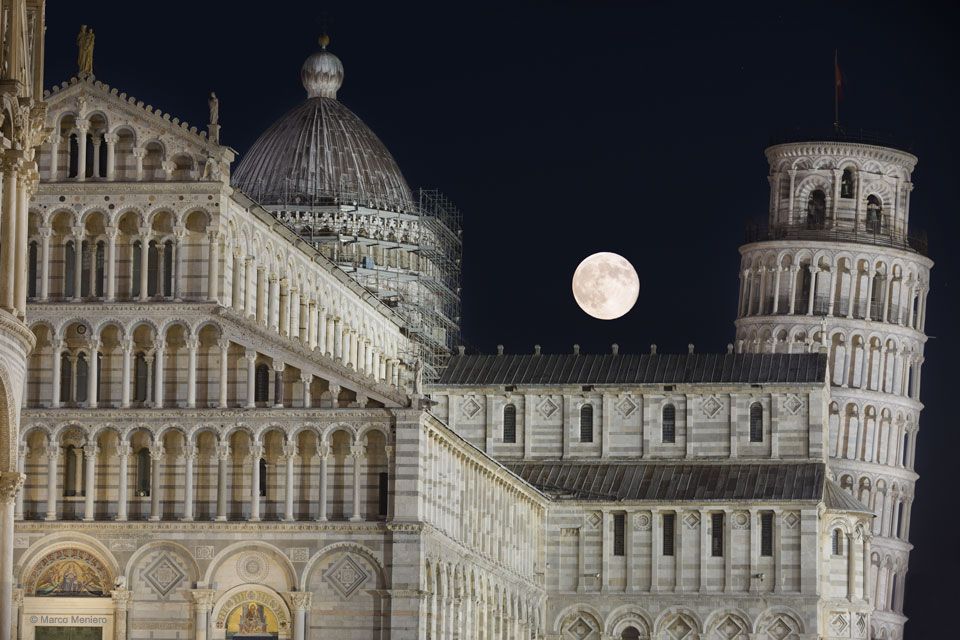
Add To Favorites
What's wrong with this picture? If you figure it out, you may then realize where the image was taken. The oddity lies actually in one of the buildings -- it leans. The Leaning Tower of Pisa has been an iconic legend since shortly after its construction began in the year 1173. Now part of a UNESCO World Heritage Site, folklore holds that Galileo used the leaning tower to dramatically demonstrate the gravitational principle that objects of different mass fall the same. Between the Leaning Tower of Pisa on the right and Pisa Cathedral and the Pisa Baptistery on the left, a full "Thunder" moon was visible last week when the image composite was taken. Using modern analyses, the tower has been successfully stabilized and, barring the unexpected, should hold its present tilt for the next 200 years. Indonesia: New APOD Mirror Site in Indonesian
2017-07-18 Marco Meniero
Add To Favorites
Fans of our fair planet might recognize the outlines of these cosmic clouds. On the left, bright emission outlined by dark, obscuring dust lanes seems to trace a continental shape, lending the popular name North America Nebula to the emission region cataloged as NGC 7000. To the right, just off the North America Nebula's east coast, is IC 5070, whose avian profile suggests the Pelican Nebula. The two bright nebulae are about 1,500 light-years away, part of the same large and complex star forming region, almost as nearby as the better-known Orion Nebula. At that distance, the 3 degree wide field of view would span 80 light-years. This careful cosmic portrait uses narrowband images combined to highlight the bright ionization fronts and the characteristic glow from atomic hydrogen, and oxygen gas. These nebulae can be seen with binoculars from a dark location. Look northeast of bright star Deneb in Cygnus the Swan, soaring high in the northern summer night sky.
2022-09-08 Frank Sackenheim
Add To Favorites
Gorgeous spiral galaxy Messier 33 seems to have more than its fair share of glowing hydrogen gas. A prominent member of the local group of galaxies, M33 is also known as the Triangulum Galaxy and lies a mere 3 million light-years away. The galaxy's central 30,000 light-years or so are shown in this sharp galaxy portrait. The portrait features M33's reddish ionized hydrogen clouds or HII regions. Sprawling along loose spiral arms that wind toward the core, M33's giant HII regions are some of the largest known stellar nurseries, sites of the formation of short-lived but very massive stars. Intense ultraviolet radiation from the luminous, massive stars ionizes the surrounding hydrogen gas and ultimately produces the characteristic red glow. In this image, broadband data were combined with narrowband data recorded through a hydrogen-alpha filter. That filter transmits the light of the strongest visible hydrogen emission line.
2023-10-13 Reinhold Wittich
Add To Favorites
The highest peak on planet Earth is framed in this mountain and night skyscape. On September 30, the digital stack of 240 sequential exposures made with a camera fixed to a tripod at an Everest Base Camp captured the sheer north face of the Himalayan mountain and foreground illuminated by bright moonlight. Taken over 1.5 hours, the sequence also recorded colorful star trails. Reflecting the planet's daily rotation on its axis, their motion is along gentle concentric arcs centered on the south celestial pole, a point well below the rugged horizon. The color of the trails actually indicates the temperatures of the stars. Blueish hues are from hotter stars, and yellow to reddish hues are from stars cooler than the Sun.
2018-12-01 Jeff Dai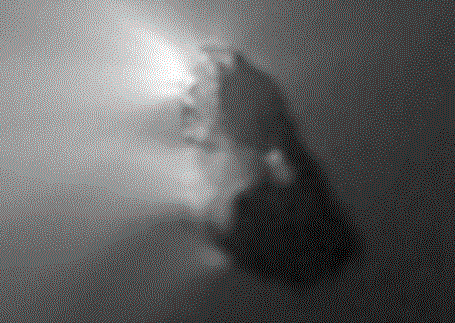
Add To Favorites
Here is what a comet nucleus really looks like. For all active comets except Halley, it was only possible to see the surrounding opaque gas cloud called the coma. During Comet Halley's most recent pass through the inner Solar System in 1986, however, spacecraft Giotto was able to go right up to the comet and photograph its nucleus. The above image is a composite of hundreds of these photographs. Although the most famous comet, Halley achieved in 1986 only 1/10th the brightness that Comet Hyakutake did last year, and a similar comparison is likely with next year's pass of Comet Hale-Bopp. Every 76 years Comet Halley comes around again, and each time the nucleus sheds about 6 meters of ice and rock into space. This debris composes Halley's tails and leaves an orbiting trail that, when falling to Earth, are called the Orionids Meteor Shower.
1996-12-10 : MPAE
Add To Favorites
The center of our Milky Way Galaxy is hidden from the prying eyes of optical telescopes by clouds of obscuring dust and gas. But in this stunning vista, the Spitzer Space Telescope's infrared cameras, penetrate much of the dust revealing the stars of the crowded galactic center region. A mosaic of many smaller snapshots, the detailed, false-color image shows older, cool stars in bluish hues. Reddish glowing dust clouds are associated with young, hot stars in stellar nurseries. The galactic center lies some 26,000 light-years away, toward the constellation Sagittarius. At that distance, this picture spans about 900 light-years.
2006-01-13